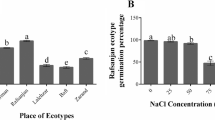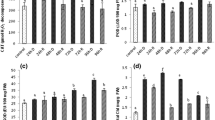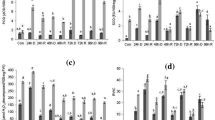Abstract
The vegetative desiccation tolerance of Selaginella brachystachya has been evaluated for its ability to revive from a desiccation (air dry) state and start normal functioning when rehydrated. In this study, S. brachystachya was identified by DNA barcoding. Experiments were conducted using the detached hydrated, desiccated and rehydrated fronds under laboratory conditions to understand the mechanism of revival upon the water availability. Scanning Electron Microscope images during desiccation showed closed stomata and inside curled leaves. Chlorophyll concentration decreased by 1.1 fold in desiccated state and recovered completely upon rehydration. However, the total carotenoid content decreased 4.5 fold while the anthocyanin concentration increased 5.98 fold and the CO2 exchange rate became negative during desiccation. Lipid peroxidation and superoxide radical production were enhanced during desiccation by 68.32 and 73.4%, respectively. Relative electrolyte leakage was found to be minimal during desiccation. Activities of antioxidant enzymes, namely peroxidase (158.33%), glutathione reductase (107.70%), catalase (92.95%) and superoxide dismutase (184.70%) were found to be higher in the desiccated state. The proline concentration increased by 1.4 fold, starch concentration decreased 3.9 fold and sucrose content increased 2.8 fold during desiccation. Upon rehydration, S. brachystachya recovered its original morphology, physiological and biochemical functions. Our results demonstrate that S. brachystachya minimizes desiccation stress through a range of morphological, physiological and biochemical mechanisms. These results provide useful insights into desiccation tolerance mechanisms for potential utilization in enhancing stress tolerance in crop plants.







Similar content being viewed by others
Data availability
The data that support the findings of this study are available from the corresponding author upon reasonable request.
References
Abdalla KO, Baker B, Rafudeen MS (2010) Proteomic analysis of nuclear proteins during dehydration of the resurrection plant Xerophyta viscosa. Plant Growth Regul 62:279–292. https://doi.org/10.1007/s10725-010-9497-2
Abouzari A, Fakheri BA (2015) Reactive oxygen species: generation, oxidative damage, and signal transduction. Int J Life Sci 9:3–17. https://doi.org/10.3126/ijls.v9i5.12699
Aidar ST, Chaves ARM, Fernandes Jr PI, et al (2017) Vegetative desiccation tolerance of Tripogon spicatus (Poaceae) from the tropical semiarid region of northeastern Brazil. Funct Plant Biol 44:1124. https://doi.org/10.1071/FP17066
Alam A, Dwivedi A, Emmanuel I (2019) Resurrection plants: Imperative resources in develo** strategies to drought and desiccation pressure. Plant Sci Today 6:333. https://doi.org/10.14719/pst.2019.6.3.542
Anwar Hossain M, Hoque MdA, Burritt DJ, Fujita M (2014) Proline protects plants against abiotic oxidative stress. oxidative damage to plants. Elsevier, Amsterdam, pp 477–522
Apel K, Hirt H (2004) REACTIVE OXYGEN SPECIES: metabolism, oxidative stress, and signal transduction. Annu Rev Plant Biol 55:373–399. https://doi.org/10.1146/annurev.arplant.55.031903.141701
Asami P, Rupasinghe T, Moghaddam L et al (2019) Roots of the Resurrection Plant Tripogon loliiformis survive desiccation without the activation of autophagy pathways by maintaining energy reserves. Front Plant Sci. https://doi.org/10.3389/fpls.2019.00459
Ashraf M, Foolad MR (2007) Roles of glycine betaine and proline in improving plant abiotic stress resistance. Environ Exp Bot 59:206–216. https://doi.org/10.1016/j.envexpbot.2005.12.006
Bartels D (2005) Desiccation tolerance studied in the resurrection plant craterostigma plantagineum. Int Comp Biol 45:696–701. https://doi.org/10.1093/icb/45.5.696
Bartels D, Hussain SS (2011) Resurrection plants: physiology and molecular biology. In: Lüttge U, Beck E, Bartels D (eds) Plant desiccation tolerance. Springer Berlin Heidelberg, Berlin, Heidelberg, pp 339–364
Bechtold U (2018) Plant life in extreme environments: how do you improve drought tolerance? Front Plant Sci. https://doi.org/10.3389/fpls.2018.00543
Bentley BL (1999) physiological ecology of north american desert plants. S. D. Smith, R. K. Monson, J. E. Anderson. Structure-function relations of warm desert plants Arthur C Gibson. Quart Rev Biol 74:104–105. https://doi.org/10.1086/393042
Bewley JD (1979) Physiological aspects of desiccation tolerance. Ann Rev Plant Physiol 30:195–238. https://doi.org/10.1146/annurev.pp.30.060179.001211
Blokhina O, Virolainen E, Fagerstedt KV (2003) Antioxidants, oxidative damage and oxygen deprivation stress: a review. Ann Bot 91:179–194. https://doi.org/10.1093/aob/mcf118
Blomstedt C, Griffiths C, Gaff D et al (2018) Plant desiccation tolerance and its regulation in the foliage of resurrection “flowering-plant” species. Agrono 8:146. https://doi.org/10.3390/agronomy8080146
Brighigna L, Bennici A, Tani C, Tani G (2002) Structural and ultrastructural characterization of Selaginella lepidophylla, a desiccation-tolerant plant, during the rehydration process. Flora Morphol Distrib Funct Ecol Plants 197:81–91. https://doi.org/10.1078/0367-2530-00018
Brulé V, Rafsanjani A, Asgari M et al (2019) Three-dimensional functional gradients direct stem curling in the resurrection plant Selaginella lepidophylla. J R Soc Interface 16:20190454. https://doi.org/10.1098/rsif.2019.0454
Bulgari R, Trivellini A, Ferrante A (2019) Effects of two doses of organic extract-based biostimulant on greenhouse lettuce grown under increasing NaCl concentrations. Front Plant Sci. https://doi.org/10.3389/fpls.2018.01870
Challabathula D, Bartels D (2013) Desiccation tolerance in resurrection plants: new insights from transcriptome, proteome and metabolome analysis. Front Plant Sci. https://doi.org/10.3389/fpls.2013.00482
Challabathula D, Zhang Q, Bartels D (2018) Protection of photosynthesis in desiccation-tolerant resurrection plants. J Plant Physiol 227:84–92. https://doi.org/10.1016/j.jplph.2018.05.002
Chaves MM (1991) Effects of water deficits on carbon assimilation. J Exp Bot 42:1–16. https://doi.org/10.1093/jxb/42.1.1
Chen Y, Zhi J, Zhang H et al (2017) Transcriptome analysis of Phytolacca americana L. in response to cadmium stress. PLoS ONE 12:e184681. https://doi.org/10.1371/journal.pone.0184681
Christ B, Egert A, Süssenbacher I et al (2014) Water deficit induces chlorophyll degradation via the “PAO/phyllobilin” pathway in leaves of homoio-(Craterostigma pumilum ) and poikilochlorophyllous (Xerophyta viscosa ) resurrection plants: chlorophyll breakdown in resurrection plants. Plant Cell Environ 37:2521–2531. https://doi.org/10.1111/pce.12308
Coombs J, Hind G, Leegood RC, Tieszen LL, Vonshak A (1985) Analytical techniques. In: Coombs J, Hall DO, Long SP, Scurlock JM (eds) Techniques in bioproductivity and photosynthesis. Pergamon Press, Oxford, pp 223–226
Cooper K (2002) Recovery of the resurrection plant Craterostigma wilmsii from desiccation: protection versus repair. J Exp Bot 53:1805–1813. https://doi.org/10.1093/jxb/erf028
Crowe JH, Hoekstra FA, Crowe LM (1992) Anhydrobiosis. Annu Rev Physiol 54:579–599. https://doi.org/10.1146/annurev.ph.54.030192.003051
Csintalan Z, Tuba Z, Lichtenthaler HK, Grace J (1996) Reconstitution of photosynthesis upon rehydration in the desiccated leaves of the Poikilochlorophyllous Shrub Xerophyta scabrida at elevated CO2. J Plant Physiol 148:345–350. https://doi.org/10.1016/S0176-1617(96)80263-X
Das K, Roychoudhury A (2014) Reactive oxygen species (ROS) and response of antioxidants as ROS-scavengers during environmental stress in plants. Front Environ Sci. https://doi.org/10.3389/fenvs.2014.00053
De Ronde JA, Cress WA, Krüger GHJ et al (2004) Photosynthetic response of transgenic soybean plants, containing an Arabidopsis P5CR gene, during heat and drought stress. J Plant Physiol 161:1211–1224. https://doi.org/10.1016/j.jplph.2004.01.014
Deeba F, Pandey V (2017) Adaptive mechanisms of desiccation tolerance in resurrection plants. In: Shukla V, Kumar S, Kumar N (eds) Plant adaptation strategies in changing environment. Springer, Singapore, pp 29–75
Deeba F, Pandey V, Pathre U, Kanojiya S (2009) Proteome Analysis of detached fronds from a resurrection plant Selaginella bryopteris— response to dehydration and rehydration. J Proteomics Bioinform 02:108–116. https://doi.org/10.4172/jpb.1000067
Dinakar C, Djilianov D, Bartels D (2012) Photosynthesis in desiccation tolerant plants: energy metabolism and antioxidative stress defense. Plant Sci 182:29–41. https://doi.org/10.1016/j.plantsci.2011.01.018
Doyle JJ, Doyle JL (1987) A rapid DNA isolation procedure for small quantities of fresh leaf tissue. In: Phytochemical bulletin. https://worldveg.tind.io/record/33886. (Accessed 22 Jun 2020)
Dutta T, Neelapu NRR, Wani SH, Challa S (2018) Compatible solute engineering of crop plants for improved tolerance toward abiotic stresses. Biochemical, physiological and molecular avenues for combating abiotic stress tolerance in plants. Elsevier, Amsterdam, pp 221–254
Farrant JM, Moore JP (2011) Programming desiccation-tolerance: from plants to seeds to resurrection plants. Curr Opin Plant Biol 14:340–345. https://doi.org/10.1016/j.pbi.2011.03.018
Farrant J, Brandt W, Lindsey G (2007) An overview of mechanisms of desiccation tolerance in selected angiosperm resurrection plants. Plant Stress 1749–0359(1):72–84
Farrant JM, Cooper K, Hilgart A et al (2015) A molecular physiological review of vegetative desiccation tolerance in the resurrection plant Xerophyta viscosa (Baker). Planta 242:407–426. https://doi.org/10.1007/s00425-015-2320-6
Fazekas A, Burgess K, Kesanakurti P et al (2008) Multiple multilocus DNA barcodes from the plastid genome discriminate plant species equally well. PLoS ONE 3:e2802. https://doi.org/10.1371/journal.pone.0002802
Fryer MJ, Ball L, Oxborough K et al (2003) Control of Ascorbate Peroxidase 2 expression by hydrogen peroxide and leaf water status during excess light stress reveals a functional organisation of Arabidopsis leaves. Plant J 33:691–705. https://doi.org/10.1046/j.1365-313x.2003.01656.x
Gaff DF, Bole PV (1986) Resurrection grasses in India. Oecologia 71:159–160. https://doi.org/10.1007/BF00377337
Gaff DF, Oliver M (2013) The evolution of desiccation tolerance in angiosperm plants: a rare yet common phenomenon. Funct Plant Biol 40:315. https://doi.org/10.1071/FP12321
Garg N, Manchanda G (2009) ROS generation in plants: boon or bane? Plant Biosyst 143:81–96. https://doi.org/10.1080/11263500802633626
Georgieva K, Röding A, Büchel C (2009) Changes in some thylakoid membrane proteins and pigments upon desiccation of the resurrection plant Haberlea rhodopensis. J Plant Physiol 166:1520–1528. https://doi.org/10.1016/j.jplph.2009.03.010
Gill SS, Tuteja N (2010) Reactive oxygen species and antioxidant machinery in abiotic stress tolerance in crop plants. Plant Physiol Biochem 48:909–930. https://doi.org/10.1016/j.plaphy.2010.08.016
Gu W, Song J, Cao Y et al (2013) Application of the ITS2 region for barcoding medicinal plants of Selaginellaceae in Pteridophyta. PLoS ONE. https://doi.org/10.1371/journal.pone.0067818
Gururani MA, Venkatesh J, Ganesan M et al (2015) In vivo assessment of cold tolerance through chlorophyll-a fluorescence in transgenic Zoysiagrass expressing mutant phytochrome A. PLoS ONE 10:e0127200. https://doi.org/10.1371/journal.pone.0127200
Halliwell B, Foyer CH (1978) Properties and physiological function of a glutathione reductase purified from spinach leaves by affinity chromatography. Planta 139:9–17. https://doi.org/10.1007/BF00390803
Heath RL, Packer L (1968) Photoperoxidation in isolated chloroplasts: I. kinetics and stoichiometry of fatty acid peroxidation. Archi Biochem Biophysic 125:189–198. https://doi.org/10.1016/0003-9861(68)90654-1
Iturriaga G, Cushman M, Cushman J (2006) An EST catalogue from the resurrection plant Selaginella lepidophylla reveals abiotic stress-adaptive genes. Plant Sci 170:1173–1184. https://doi.org/10.1016/j.plantsci.2006.02.004
Jogaiah S, Govind SR, Tran L-SP (2013) Systems biology-based approaches toward understanding drought tolerance in food crops. Crit Rev Biotechnol 33:23–39. https://doi.org/10.3109/07388551.2012.659174
Joshi K (2019) The impact of drought on human capital in rural India. Environ Dev Econ 24:413–436. https://doi.org/10.1017/S1355770X19000123
Kavi Kishor PB, Sreenivasulu N (2014) Is proline accumulation per se correlated with stress tolerance or is proline homeostasis a more critical issue? Plant Cell Environ 37:300–311. https://doi.org/10.1111/pce.12157
Kuai B, Chen J, Hörtensteiner S (2018) The biochemistry and molecular biology of chlorophyll breakdown. J Exp Bot 69:751–767. https://doi.org/10.1093/jxb/erx322
Kumar S, Stecher G, Li M et al (2018) MEGA X: molecular evolutionary genetics analysis across computing platforms. Mol Biol Evol 35:1547–1549. https://doi.org/10.1093/molbev/msy096
Lamaoui M, Jemo M, Datla R, Bekkaoui F (2018) Heat and drought stresses in crops and approaches for their mitigation. Front Chem. https://doi.org/10.3389/fchem.2018.00026
Lee J, Durst RW, Wrolstad RE et al (2005) Determination of total monomeric anthocyanin pigment content of fruit juices, beverages, natural colorants, and wines by the ph differential method: collaborative study. J AOAC Int 88:1269–1278. https://doi.org/10.1093/jaoac/88.5.1269
Lemoine R, Camera SL, Atanassova R et al (2013) Source-to-sink transport of sugar and regulation by environmental factors. Front Plant Sci. https://doi.org/10.3389/fpls.2013.00272
Leprince O, Buitink J (2010) Desiccation tolerance: from genomics to the field. Plant Sci 179:554–564. https://doi.org/10.1016/j.plantsci.2010.02.011
Li A, Wang D, Yu B et al (2014) Maintenance or collapse: responses of extraplastidic membrane lipid composition to desiccation in the resurrection plant Paraisometrum mileense. PLoS ONE 9:e103430. https://doi.org/10.1371/journal.pone.0103430
Li W-J, McKenzie EHC, Liu (Jack) J-K et al (2020) Taxonomy and phylogeny of hyaline-spored coelomycetes. Fung Div 100:279–801. https://doi.org/10.1007/s13225-020-00440-y
Lichtenthaler HK (1987) [34] Chlorophylls and carotenoids: pigments of photosynthetic biomembranes. Methods in Enzymology. Academic Press, Cambridge, pp 350–382
Liu M-S, Chien C-T, Lin T-P (2008) Constitutive components and induced gene expression are involved in the desiccation tolerance of Selaginella tamariscina. Plant Cell Physiol 49:653–663. https://doi.org/10.1093/pcp/pcn040
Manickam VS, Irudayaraj V (1991) Pteridophyte flora of the western ghats. B.I. Publications, South India
Martinelli T, Whittaker A, Bochicchio A et al (2007) Amino acid pattern and glutamate metabolism during dehydration stress in the “resurrection” plant Sporobolus stapfianus: a comparison between desiccation-sensitive and desiccation-tolerant leaves. J Exp Bot 58:3037–3046. https://doi.org/10.1093/jxb/erm161
Mattos LM, Moretti CL (2016) Oxidative stress in plants under drought conditions and the role of different enzymes. Enz Eng. https://doi.org/10.4172/2329-6674.1000136
Mitra J, Xu G, Wang B et al (2013) Understanding desiccation tolerance using the resurrection plant Boea hygrometrica as a model system. Front Plant Sci. https://doi.org/10.3389/fpls.2013.00446
Mittler R, Merquiol E, Hallak-Herr E et al (2001) Living under a “dormant” canopy: a molecular acclimation mechanism of the desert plant Retama raetam: molecular acclimation of desert plants. Plant J 25:407–416. https://doi.org/10.1046/j.1365-313x.2001.00975.x
Moore JP, Farrant JM (2015) Editorial: current advances and challenges in understanding plant desiccation tolerance. Front Plant Sci. https://doi.org/10.3389/fpls.2015.00768
Murray JR, Hackett WP (1991) Dihydroflavonol reductase activity in relation to differential anthocyanin accumulation in juvenile and mature phase hedera helix L. Plant Physiol 97:343–351. https://doi.org/10.1104/pp.97.1.343
Nar H, Saglam A, Terzi R et al (2009) Leaf rolling and photosystem II efficiency in Ctenanthe setosa exposed to drought stress. Photosynthetica 47:429–436. https://doi.org/10.1007/s11099-009-0066-8
Neeragunda SY, Barbara P, Gugi B et al (2018) Perspectives on structural, physiological, cellular, and molecular responses to desiccation in resurrection plants. Scientifica 2018:1–18. https://doi.org/10.1155/2018/9464592
Norwood M, Truesdale MR, Richter A, Scott P (2000) Photosynthetic carbohydrate metabolism in the resurrection plant Craterostigma plantagineum. J Exp Bot 51:159–165. https://doi.org/10.1093/jexbot/51.343.159
Oliver MJ, Dowd SE, Zaragoza J et al (2004) The rehydration transcriptome of the desiccation-tolerant bryophyte Tortula ruralis: transcript classification and analysis. BMC Genom 5:89. https://doi.org/10.1186/1471-2164-5-89
Oliver MJ, Farrant JM, Hilhorst HWM et al (2020) Desiccation tolerance: avoiding cellular damage during drying and rehydration. Annu Rev Plant Biol 71:435–460. https://doi.org/10.1146/annurev-arplant-071219-105542
Pandey V, Ranjan S, Deeba F et al (2010) Desiccation-induced physiological and biochemical changes in resurrection plant, Selaginella bryopteris. J Plant Physiol 167:1351–1359. https://doi.org/10.1016/j.jplph.2010.05.001
Parvaiz A, Satyawati S (2008) Salt stress and phyto-biochemical responses of plants—a review. Plant Soil Environ 54:89–99. https://doi.org/10.17221/2774-PSE
Pizarro M, Contreras RA, Köhler H, Zúñiga GE (2019) Desiccation tolerance in the Antarctic moss Sanionia uncinata. Biol Res 52:46. https://doi.org/10.1186/s40659-019-0251-6
Plancot B, Gügi B, Mollet J-C et al (2019) Desiccation tolerance in plants: structural characterization of the cell wall hemicellulosic polysaccharides in three Selaginella species. Carbohydr Polym 208:180–190. https://doi.org/10.1016/j.carbpol.2018.12.051
Poli Y, Nallamothu V, Balakrishnan D et al (2018) Increased catalase activity and maintenance of photosystem ii distinguishes high-yield mutants from low-yield mutants of rice var. Nagina22 under low-phosphorus stress. Front Plant Sci. https://doi.org/10.3389/fpls.2018.01543
Quartacci MF, Forli M, Rascio N, Vecchia FD, Bochicchio A, Navari-Izzo F (1997) Desiccation-tolerant Sporobolus stapfianus: lipid composition and cellular ultrastructure during dehydration and rehydration. J Exp Bot 48:1269–1279. https://doi.org/10.1093/jxb/48.6.1269
Quartacci M, Glisić O, Stevanović B, Navari-Izzo F (2002) Plasma membrane lipids in the resurrection plant Ramonda serbica following dehydration and rehydration. J Exp Bot 53:2159–2166. https://doi.org/10.1093/jxb/erf076
Rafsanjani A, Brulé V, Western TL, Pasini D (2015) Hydro-responsive curling of the resurrection plant Selaginella lepidophylla. Sci Rep. https://doi.org/10.1038/srep08064
Rao MV, Hale BA, Ormrod DP (1995) Amelioration of ozone-induced oxidative damage in wheat plants grown under high carbon dioxide (role of antioxidant enzymes). Plant Physiol 109:421–432. https://doi.org/10.1104/pp.109.2.421
Rodriguez MCS, Edsgärd D, Hussain SS et al (2010) Transcriptomes of the desiccation-tolerant resurrection plant Craterostigma plantagineum: transcriptomes of Craterostigma plantagineum. Plant J 63:212–228. https://doi.org/10.1111/j.1365-313X.2010.04243.x
Schulze ED (1986) Whole-plant responses to drought. Functional Plant Biol 13:127–141. https://doi.org/10.1071/pp9860127
Sherwin H, Farrant J (1998) Protection mechanisms against excess light in the resurrection plants Craterostigma wilmsii and Xerophyta viscosa. Plant Growth Regul 24:203–210. https://doi.org/10.1023/A:1005801610891
Sims DA, Gamon JA (2002) Relationships between leaf pigment content and spectral reflectance across a wide range of species, leaf structures and developmental stages. Remote Sens Environ 81:337–354. https://doi.org/10.1016/S0034-4257(02)00010-X
Szabados L, Savouré A (2010) Proline: a multifunctional amino acid. Trends Plant Sci 15:89–97. https://doi.org/10.1016/j.tplants.2009.11.009
Vander Willigen C (2004) Mechanical stabilization of desiccated vegetative tissues of the resurrection grass Eragrostis nindensis: does a TIP 3;1 and/or compartmentalization of subcellular components and metabolites play a role? J Exp Bot 55:651–661. https://doi.org/10.1093/jxb/erh089
Vicré M, Farrant JM, Driouich A (2004) Insights into the cellular mechanisms of desiccation tolerance among angiosperm resurrection plant species: desiccation tolerance strategies of angiosperm resurrection plants. Plant Cell Envirn 27:1329–1340. https://doi.org/10.1111/j.1365-3040.2004.01212.x
Wang X, Chen S, Zhang H et al (2010) Desiccation tolerance mechanism in resurrection fern-ally Selaginella tamariscina revealed by physiological and proteomic analysis. J Proteome Res 9:6561–6577. https://doi.org/10.1021/pr100767k
Wang H, Tang X, Wang H, Shao H-B (2015) Proline accumulation and metabolism-related genes expression profiles in Kosteletzkya virginica seedlings under salt stress. Front Plant Sci. https://doi.org/10.3389/fpls.2015.00792
Weger HG, Silim SN, Guy RD (1993) Photosynthetic acclimation to low temperature by western red cedar seedlings. Plant Cell Environ 16:711–717. https://doi.org/10.1111/j.1365-3040.1993.tb00490.x
Whittaker A, Bochicchio A, Vazzana C et al (2001) Changes in leaf hexokinase activity and metabolite levels in response to drying in the desiccation-tolerant species Sporobolus stapfianus and Xerophyta viscosa. J Exp Bot 52:961–969. https://doi.org/10.1093/jexbot/52.358.961
Yang Y, Zhang L, Huang X et al (2020) Response of photosynthesis to different concentrations of heavy metals in Davidia involucrata. PLoS ONE 15:e0228563. https://doi.org/10.1371/journal.pone.0228563
Yathisha NS, Barbara P, Gügi B et al (2020) Vegetative desiccation tolerance in Eragrostiella brachyphylla: biochemical and physiological responses. Heliyon 6:e04948. https://doi.org/10.1016/j.heliyon.2020.e04948
Yobi A, Schlauch KA, Tillett RL et al (2017) Sporobolus stapfianus: Insights into desiccation tolerance in the resurrection grasses from linking transcriptomics to metabolomics. BMC Plant Biol 17:67. https://doi.org/10.1186/s12870-017-1013-7
You J, Chan Z (2015) ROS regulation during abiotic stress responses in crop plants. Front Plant Sci. https://doi.org/10.3389/fpls.2015.01092
Acknowledgements
Authors are Grateful to CEFIPRA/IFCPRA. New Delhi. India for funding support [Project No. IFC/5300-BA/2015/36]. Entitled "A Comparative Systems Biology Approach for Understanding Desiccation Tolerance in Forage Grasses and Selaginella sps". We thank Tumkur University, Karnataka, India, University of Rouen, Rouen, France and Kuvempu University, Karnataka, India for providing Infrastructure and administrative support to carry out this research work.
Author information
Authors and Affiliations
Contributions
YNS, BP, and BG, conducted the survey, collected plants, performed the experiments, analyzed the data and wrote the manuscript. YR conducted Scanning Electron Microscopy. JS done molecular identification of experimental plant species. AD, SRG and YK designed the experiments and corrected the manuscript. All authors read and approved the final manuscript for publication.
Corresponding author
Ethics declarations
Conflict of Interest
The authors declare that they have no conflicts of interest.
Supplementary Information
Below is the link to the electronic supplementary material.
Rights and permissions
About this article
Cite this article
Neeragunda Shivaraj, Y., Plancot, B., Ramdani, Y. et al. Physiological and biochemical responses involved in vegetative desiccation tolerance of resurrection plant Selaginella brachystachya. 3 Biotech 11, 135 (2021). https://doi.org/10.1007/s13205-021-02667-1
Received:
Accepted:
Published:
DOI: https://doi.org/10.1007/s13205-021-02667-1




